Some people think that by definition a museum should have grand paintings or ancient statues and take all day to visit. Museums of everyday history like historic homes and local history museums are more likely to present more mundane items of common use over a period of time in a particular place. Archaeological museums may have grand discoveries like artifacts from ancient Egypt or Angkor Wat. In fact, many people go into archaeology with a romantic notion of going off and discovering mythical civilizations a la Indiana Jones. In reality a lot of the field work is digging around in the refuse of a bygone era. However, in looking at what people chose to discard or build over, even close to home, sometimes researchers do uncover a lost city.
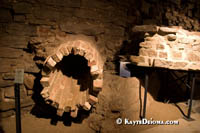 That’s what happened when the Society for Development of the Old Port had archaeologists survey the Pointe-ŕ-Calličre in Old Montreal with the intention of creating a park across from the Old Customs House. What they found were remnants of previous occupants of the site all the way back to the city’s founding in 1642. Stone walls of generations of earlier buildings had been built over the first Catholic cemetery where French settlers and Indians were buried side by side.
That’s what happened when the Society for Development of the Old Port had archaeologists survey the Pointe-ŕ-Calličre in Old Montreal with the intention of creating a park across from the Old Customs House. What they found were remnants of previous occupants of the site all the way back to the city’s founding in 1642. Stone walls of generations of earlier buildings had been built over the first Catholic cemetery where French settlers and Indians were buried side by side.
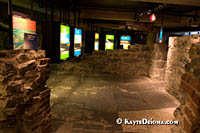 The archaeological site was deemed too important to be covered with a park. The challenge was how to preserve the site from deterioration, yet make it accessible to the public. The solution was the Pointe-ŕ-Calličre, Montréal Museum of Archaeology and History, also known as PAC. The museum was created by re-building Place Royal, the city’s first public square, and the new Éperon building overtop of the underground site in such a way that visitors could explore the excavation below. The underground passages extend under the Old Customs House, which was incorporated into the museum.
The archaeological site was deemed too important to be covered with a park. The challenge was how to preserve the site from deterioration, yet make it accessible to the public. The solution was the Pointe-ŕ-Calličre, Montréal Museum of Archaeology and History, also known as PAC. The museum was created by re-building Place Royal, the city’s first public square, and the new Éperon building overtop of the underground site in such a way that visitors could explore the excavation below. The underground passages extend under the Old Customs House, which was incorporated into the museum.
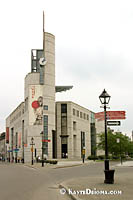 Pointe-ŕ-Calličre is the point formed by the joining of the Little St. Pierre River and the St. Lawrence River when the original French settlement of Ville Marie was established at this spot on the Island of Montreal. It was named for Louis-Hector de Calličre, third Governor of Montreal, who built his home here. The Little St. Pierre was later turned into a covered sewer system and then disappeared altogether. Although the little river is no more, the contemporary gray masonry façade and clock tower of the Éperon building conform to the shape of the point and the buildings that existed previously on this site. The entrance to the underground complex is through this modern structure.
Pointe-ŕ-Calličre is the point formed by the joining of the Little St. Pierre River and the St. Lawrence River when the original French settlement of Ville Marie was established at this spot on the Island of Montreal. It was named for Louis-Hector de Calličre, third Governor of Montreal, who built his home here. The Little St. Pierre was later turned into a covered sewer system and then disappeared altogether. Although the little river is no more, the contemporary gray masonry façade and clock tower of the Éperon building conform to the shape of the point and the buildings that existed previously on this site. The entrance to the underground complex is through this modern structure.
In the multimedia theatre, a 20-minute video introduction in French with English translation via headsets is projected onto translucent screens suspended into the ruins below. A brief history of Montreal and Point-a-Calliere is narrated by Montreal’s founder, missionary Paul Chomedey de Maisonneuve, who leads you through the centuries.
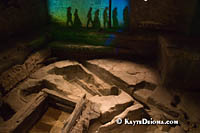 The primary exhibit at Pointe-ŕ-Calličre is the archaeological site itself, where you can see how an outhouse was situated above the graves in the first Catholic cemetery and wander among the stone walls to see how buildings were built on top of previous structures. You can walk where the Little St. Pierre River was channeled into the sewage canal with protruding brick conduits and you can see remains of Governor Calličre’s home.
The primary exhibit at Pointe-ŕ-Calličre is the archaeological site itself, where you can see how an outhouse was situated above the graves in the first Catholic cemetery and wander among the stone walls to see how buildings were built on top of previous structures. You can walk where the Little St. Pierre River was channeled into the sewage canal with protruding brick conduits and you can see remains of Governor Calličre’s home.
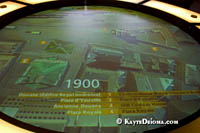 In addition to the excavated ruins, the artifacts found in the dig are displayed and interpreted according to the appropriate time period from Indian arrowheads to an 18 th century chamber pot and a 20 th century milk bottle. Multicolored information displays provide the history and significance of the times and the artifacts. A large interactive circular display lets you see the layout of the area in whatever time period you select. Glass windows in the floor show models of the neighborhood through the ages. At the far end toward the Customs House, motion-activated historic characters emerge
In addition to the excavated ruins, the artifacts found in the dig are displayed and interpreted according to the appropriate time period from Indian arrowheads to an 18 th century chamber pot and a 20 th century milk bottle. Multicolored information displays provide the history and significance of the times and the artifacts. A large interactive circular display lets you see the layout of the area in whatever time period you select. Glass windows in the floor show models of the neighborhood through the ages. At the far end toward the Customs House, motion-activated historic characters emerge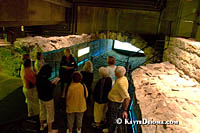 holographically from the stone walls to tell their story.
holographically from the stone walls to tell their story.
A semi-permanent exhibit, Montreal Love Stories, is on display in the Old Customs House. It is a celebration of Montreal’s multicultural couples and family traditions. The upper galleries in the Éperon building host a variety of traveling exhibits. There is also an excellent restaurant, L’Arrivage, upstairs in the Éperon. It is only open for lunch and reservations are recommended since it is very popular with local business people. The museum Gift Shop is around the corner at 150 St. Paul West.
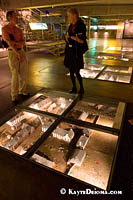 Free guided tours are available in English on Saturdays at 2:30 pm all year long with additional tours at the same time on Tuesdays, Thursdays and Sundays in the summer. French tours are at 1:30 pm on the same days.
Free guided tours are available in English on Saturdays at 2:30 pm all year long with additional tours at the same time on Tuesdays, Thursdays and Sundays in the summer. French tours are at 1:30 pm on the same days.
Pointe-ŕ-Calličre, Montréal Museum of Archaeology and History
350 Place Royale, Corner of de la Commune
Old Montréal, Quebec
H2Y 3Y5 Canada
Tel.: (514) 872-9150
E-mail: info@pacmusee.qc.ca
Website: www.pacmusee.qc.ca
Metro: Place-d’Armes station
Parking: pay parking in the Old Port.

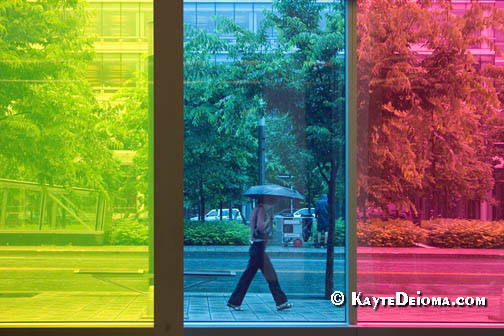
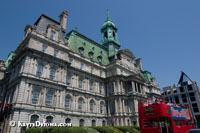 Montreal is a great place to escape from the weather any time of year. They have so much of it – snow, rain and sweltering summer heat – that they’ve come up with some ingenious ways to stay climatically comfortable all year long.
Montreal is a great place to escape from the weather any time of year. They have so much of it – snow, rain and sweltering summer heat – that they’ve come up with some ingenious ways to stay climatically comfortable all year long.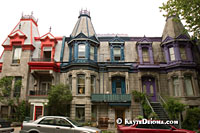 international design and architecture with its new International Quarter that links Old Montreal with the Downtown Business District. They joined the two by suspending a new office complex right over the freeway and adding branches to the RESO (from the French réseau), the largest network of interior passages in the world. Although much of it is above ground, locals refer to it as
international design and architecture with its new International Quarter that links Old Montreal with the Downtown Business District. They joined the two by suspending a new office complex right over the freeway and adding branches to the RESO (from the French réseau), the largest network of interior passages in the world. Although much of it is above ground, locals refer to it as  That’s what happened when the Society for Development of the Old Port had archaeologists survey the Pointe-ŕ-Calličre in Old Montreal with the intention of creating a park across from the Old Customs House. What they found were remnants of previous occupants of the site all the way back to the city’s founding in 1642. Stone walls of generations of earlier buildings had been built over the first Catholic cemetery where French settlers and Indians were buried side by side.
That’s what happened when the Society for Development of the Old Port had archaeologists survey the Pointe-ŕ-Calličre in Old Montreal with the intention of creating a park across from the Old Customs House. What they found were remnants of previous occupants of the site all the way back to the city’s founding in 1642. Stone walls of generations of earlier buildings had been built over the first Catholic cemetery where French settlers and Indians were buried side by side. The archaeological site was deemed too important to be covered with a park. The challenge was how to preserve the site from deterioration, yet make it accessible to the public. The solution was the Pointe-ŕ-Calličre, Montréal Museum of Archaeology and History, also known as PAC. The museum was created by re-building Place Royal, the city’s first public square, and the new Éperon building overtop of the underground site in such a way that visitors could explore the excavation below. The underground passages extend under the Old Customs House, which was incorporated into the museum.
The archaeological site was deemed too important to be covered with a park. The challenge was how to preserve the site from deterioration, yet make it accessible to the public. The solution was the Pointe-ŕ-Calličre, Montréal Museum of Archaeology and History, also known as PAC. The museum was created by re-building Place Royal, the city’s first public square, and the new Éperon building overtop of the underground site in such a way that visitors could explore the excavation below. The underground passages extend under the Old Customs House, which was incorporated into the museum. Pointe-ŕ-Calličre is the point formed by the joining of the Little St. Pierre River and the St. Lawrence River when the original French settlement of Ville Marie was established at this spot on the Island of Montreal. It was named for Louis-Hector de Calličre, third Governor of Montreal, who built his home here. The Little St. Pierre was later turned into a covered sewer system and then disappeared altogether. Although the little river is no more, the contemporary gray masonry façade and clock tower of the Éperon building conform to the shape of the point and the buildings that existed previously on this site. The entrance to the underground complex is through this modern structure.
Pointe-ŕ-Calličre is the point formed by the joining of the Little St. Pierre River and the St. Lawrence River when the original French settlement of Ville Marie was established at this spot on the Island of Montreal. It was named for Louis-Hector de Calličre, third Governor of Montreal, who built his home here. The Little St. Pierre was later turned into a covered sewer system and then disappeared altogether. Although the little river is no more, the contemporary gray masonry façade and clock tower of the Éperon building conform to the shape of the point and the buildings that existed previously on this site. The entrance to the underground complex is through this modern structure. The primary exhibit at Pointe-ŕ-Calličre is the archaeological site itself, where you can see how an outhouse was situated above the graves in the first Catholic cemetery and wander among the stone walls to see how buildings were built on top of previous structures. You can walk where the Little St. Pierre River was channeled into the sewage canal with protruding brick conduits and you can see remains of Governor Calličre’s home.
The primary exhibit at Pointe-ŕ-Calličre is the archaeological site itself, where you can see how an outhouse was situated above the graves in the first Catholic cemetery and wander among the stone walls to see how buildings were built on top of previous structures. You can walk where the Little St. Pierre River was channeled into the sewage canal with protruding brick conduits and you can see remains of Governor Calličre’s home. In addition to the excavated ruins, the artifacts found in the dig are displayed and interpreted according to the appropriate time period from Indian arrowheads to an 18 th century chamber pot and a 20 th century milk bottle. Multicolored information displays provide the history and significance of the times and the artifacts. A large interactive circular display lets you see the layout of the area in whatever time period you select. Glass windows in the floor show models of the neighborhood through the ages. At the far end toward the Customs House, motion-activated historic characters emerge
In addition to the excavated ruins, the artifacts found in the dig are displayed and interpreted according to the appropriate time period from Indian arrowheads to an 18 th century chamber pot and a 20 th century milk bottle. Multicolored information displays provide the history and significance of the times and the artifacts. A large interactive circular display lets you see the layout of the area in whatever time period you select. Glass windows in the floor show models of the neighborhood through the ages. At the far end toward the Customs House, motion-activated historic characters emerge holographically from the stone walls to tell their story.
holographically from the stone walls to tell their story. Free guided tours are available in English on Saturdays at 2:30 pm all year long with additional tours at the same time on Tuesdays, Thursdays and Sundays in the summer. French tours are at 1:30 pm on the same days.
Free guided tours are available in English on Saturdays at 2:30 pm all year long with additional tours at the same time on Tuesdays, Thursdays and Sundays in the summer. French tours are at 1:30 pm on the same days.